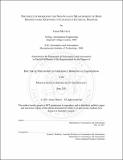Photoplethysmography for non-invasive measurement of bone hemodynamic responses to changes in external pressure
Author(s)
Mateus, Jaime (Pereira de Mateus Silva)
DownloadFull printable version (14.72Mb)
Other Contributors
Massachusetts Institute of Technology. Dept. of Aeronautics and Astronautics.
Advisor
Alan R. Hargens and Dava J. Newman.
Terms of use
Metadata
Show full item recordAbstract
Adequate blood supply and circulation in bones is required to maintain a healthy skeleton, and inadequate blood perfusion is associated with numerous bone pathologies and a decrease in bone mineral density (BMD). Bone hemodynamics remains poorly understood and loss of BMD is still one of the limiting factors to long duration human spaceflight. Developments in photoplethysmography (PPG) hardware have made it a promising tool for non-invasive bone hemodynamic measurements. The aims of this thesis are to: 1) validate the use of PPG as a tool for non-invasive bone hemodynamic measurements, 2) characterize bone hemodynamic responses to changes in external pressure, and 3) identify the predominant mechanisms regulating bone hemodynamic responses to pressure changes. A new PPG device capable of measuring bone hemodynamic responses was designed and tested. It represents the state-of-the-art in deep-tissue PPG instrumentation. Validation experiments including arterial occlusion, cold exposure, skin occlusion and nitroglycerin exposure were performed. Single-limb pressure chamber experiments were performed over a range of pressures from -50 to +50 mmHg to characterize the responses to changes in external pressure and to identify the predominant control mechanisms. Our results support the use of PPG as a valid tool for measuring bone hemodynamic responses. Bone hemodynamic responses to changes in external pressure have been characterized for the first time. We also present the first report of a myogenic response in bone and show that the myogenic effect is the predominant control mechanism in bone over a wide range of pressure levels. Myogenic-induced vasoconstriction is observed at all negative pressure levels, with increasing vasoconstriction at the more extreme pressure differences. At positive pressures we observed an initial myogenic-induced vasodilation followed by activation of the intramuscular pressure receptors at +30 mmHg which overrides the initial response and causes vasoconstriction at the highest positive pressure. The availability of a new tool for non-invasive bone hemodynamic measurements opens the door to several new research opportunities with clinical, Earth-based as well as human spaceflight applications.
Description
Thesis (Ph. D.)--Massachusetts Institute of Technology, Dept. of Aeronautics and Astronautics, 2011. Cataloged from PDF version of thesis. Includes bibliographical references (p. 123-135).
Date issued
2011Department
Massachusetts Institute of Technology. Department of Aeronautics and AstronauticsPublisher
Massachusetts Institute of Technology
Keywords
Aeronautics and Astronautics.